Analysis of Soil and Sewage Sludge by ICP-OES
The analysis of soil and sewage sludge by ICP-OES using a novel CCD optic concept, which allows for the transfer of methods between different instruments, is described. Sample preparation was performed according to EN 13346:2000. The accuracy was investigated using the standard reference materials, BCR-141R and NIST 2781. It could be demonstrated that the requirements in terms of sensitivity, precision, and accuracy to perform the analysis of soil and sewage sludge can be met. The article includes line selection, detection limits, and studies on accuracy.
Soil is a vital and largely non-renewable resource, and the importance of its protection is recognized internationally. The introduction of contaminants into the soil results in damage or loss of its functions and can cross-contaminate water, leading to negative consequences for the food chain, and, ultimately, human health. As a consequence, contamination levels in soil and sludge from urban and industrial wastewater treatment need to be controlled.

Table I. Sewage Sludge Directive 86/278/EEC
The European Union has passed several directives to be adopted by the member states to regulate the application of sewage sludge to land ("Sewage Sludge Directive 86/278/EEC" [1], "Landfill Directive 1999/31/EC" [2], "Organic Farming Regulation (EEC) No. 2092/91" [3]). They prohibit the use of sludge from treatment plants unless the specified requirements are fulfilled.
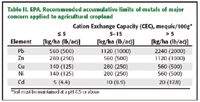
Table II. EPA, Recommended accumulative limits of metals of major concern applied to agricultural cropland
The U.S. EPA has made recommendations for the lifetime maximum amount of heavy metals that can be applied to agricultural cropland in the "EPA Process Design Manual for the Land Application Of Municipal Sludge, 1983" (4).
Due to its multielement determination capability, high dynamic linear range, and sensitivity, inductively coupled plasma-optical emission spectrometry (ICP-OES) is used widely for the analysis of soil and sludge. The application is described in standard procedures such as EPA Methods 3050 B (5) and 6010C (6), EN 13346:2000 (7), and the ISO standard ISO 11885:1996 (8).

Table III. ICP Operating Conditions
Experimental
Instrumentation: All measurements were performed with the SPECTRO GENESIS ICP optical emission spectrometer (SPECTRO Analytical Instruments, Kleve, Germany) with axial plasma observation. The instrument includes a Paschen–Runge mount spectrometer, constructed employing the optimized Rowland circle alignment (ORCA) technique. It consists of two hollow section cast shells, designed for direct thermal stabilization and small volume. The spectrometer's 15 pre-aligned linear CCD detectors, installed from the outside of the optics body, allow for a fast, simultaneous spectrum capture of the wavelength range from 175 nm to 777 nm.
For UV access (<200 nm), the optical system can be purged with argon (optionally also nitrogen can be used). The purge rate during normal operation is 0.5 L/min.
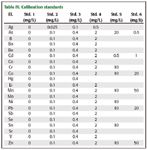
Table IV. Calibration standards
To enable method transfer between individual instruments, an intelligent calibration logic (ICAL) calibration algorithm was used to normalize the wavelength and the intensity scale of the optical system to a reference optic ("optic master").
The air-cooled ICP-generator is based upon a free-running 27.12 MHz system. All ICP operating parameters were software controlled.

Table V. LODs of the selected lines
For sample preparation, a MarsXpress microwave digestion system (CEM GmbH, Kamp-Lintfort, Germany) was used.
Sample preparation: Sample preparation was performed according to European norm EN 13346:2000 (8), which provides four methods for the preparation of sludges:
A. Extraction by boiling under reflux condition
B. Extraction by boiling in a glass tube
C. Extraction by closed-vessel microwave digestion
D. Extraction by open-vessel microwave digestion
The use of methods A and C are described in the following. For this article, the samples were prepared using method C.
Extraction by boiling under reflux condition: 3 g of milled, homogenized, and dried sample material was weighed, transferred into a reaction vessel, and moistened with 0.5–1 mL of water. After the addition of 21 mL of hydrochloric and 7 mL of nitric acid, the return condenser was connected to the reaction vessel and the mixture was first left to react at room temperature until foaming had subsided. Then it was heated until boiling occurred. After 2 h, the solution was cooled to room temperature and the content of the absorption vessel was transferred to the reaction vessel. The content of the reaction vessel is quantitatively transferred to a volumetric flask and diluted to the nominal volume.
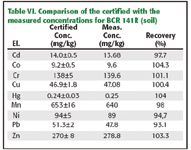
Table VI. Comparison of the certified with the measured concentrations for BCR 141R (soil)
Extraction by closed-vessel microwave digestion:
Safety Aspects: With pressure digestion, the organic content of soil and sludge can result in a critical reaction behavior. Under the conditions of the acid digestion, it can produce a strong exothermal reaction and form large quantities of gaseous products, leading to a violent pressure impulse. Therefore, the equipment used must be suitable for the reaction pressures that can develop. To avoid the formation of an exothermal reaction characteristic, microwave-assisted pressure digestion systems should be able to measure the reaction temperature in all reaction vessels and be able to control the process based upon the measured temperatures. Because of the possibility of a spontaneous reaction, full functionality of all safety interlocks should be regularly checked before starting the digestion.
Digestion Principle: Depending upon its reactivity, the sample first was filled into a high pressure resistant digestion vessel made of suitable fluorinated polymer material (for example, Teflon PFA or Hostaflon TFM) and then a mineral acid mixture was added. To reach digestion temperatures above the atmospheric boiling point, the digestion vessel was closed and sealed to be gas-proof after thoroughly mixing the sample with the acid. Finally, the samples were digested using a program with a defined digestion temperature and dwell time.
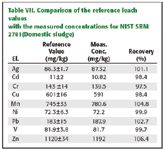
Table VII. Comparison of the reference leach values with the measured concentrations for NIST SRM 2781(Domestic sludge)
Digestion Procedure: 3 g of milled, homogenized and dried sample material was weighed and transferred into a reaction vessel. After the addition of 7 mL of nitric and 21 mL of hydrochloric acid, sample and acid were mixed by gently swiveling the vessel, so that a homogenous mixture was formed. The vessel was closed, sealed to be gas-proof, weighed, placed into the rotor, into the microwave oven, and then the digestion program was started.
The digestion program consisted of the approach to the maximum temperature of 160 °C and a dwell time of 15 min. To intensify the reflux effect, which leads to a better mixing within the vessel and a better quality of the digestion, the vessels were cooled during the process. After completion, the reaction vessels were cooled to room temperature to reduce the pressure inside and then weighed to verify that the mass lost during digestion is below 10% (m/m). Finally, the reaction vessel was opened under a laboratory fume hood. The vessel content was transferred quantitatively to a volumetric flask and diluted to the nominal volume (100 mL). Note: Undissolved constituents can be separated by centrifuging or by filtration using a membrane filter.
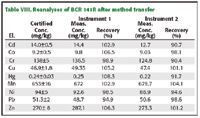
Table VIII. Reanalyses of BCR 141R after method transfer
Calibration Standards: To match the matrix, all solutions contained Al 800 mg/L, Ca 1000 mg/L, Fe 600 mg/L, K 50 mg/L, Na 20 mg/L, Ti 10 mg/L, and 28 mL of aqua regia. The analytes were added from commercially available standard solutions. After the addition, the standards were diluted to a volume of 100 mL. The concentrations of the elements in the calibration standards are given in Table II. The QC of the method was performed using the standard reference materials BCR-141R and NIST SRM 2781.
Results and Discussion
Table III shows the wavelengths selected and the limits of detection (LODs). The LODs were calculated according to the following equation (9):
LOD = 3 RSDb c/SBR
where RSDb is the relative standard deviation of 10 replicates of the blank, c is the concentration of the standard, and SBR is the signal to background ratio. The LODs were calculated referring to the dry mass (3 g sample dissolved in 100 mL) and were expressed in mg/kg in the original solid.
Accuracy: The accuracy of the developed method was investigated by analyzing the standard reference materials BCR 141R and NIST SRM 2781. As shown in Tables VI and VII, the measured and certified values are in good agreement for all the elements. To verify the transferability of the developed method, the standard materials have been remeasured after transfer to other instruments of the same model and standardization of the transferred method. As shown in Tables VIII and IX, recoveries were found to be in the same range.
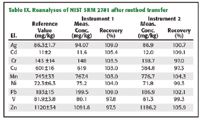
Table IX. Reanalyses of NIST SRM 2781 after method transfer
Conclusions
ICP-OES with axial plasma observation offers a simple, fast, accurate, and cost-efficient method for the analysis of soil and sewage sludge. Good recoveries were found for the standard reference materials BCR 141R and NIST SRM 2781. It can be shown that utilizing a calibration algorithm, methods can be transferred to other individual instruments of the same model once they are developed.
Because soil and sludge can be considered rather complex matrices, the technique can be applied principally to all methods that can be standardized on a higher (analyte) level. The calibration algorithm not only makes the redevelopment of the method obsolete, offering possibilities in terms of a simplification for routine applications, but it also takes the personal factor out of individually developed methods, ultimately improving the comparability of results.
References
1. 86/278/EEC COUNCIL DIRECTIVE of 12 June 1986 on the protection of the environment, and in particular of the soil, when sewage sludge is used in agriculture.
2. Council Directive 1999/31/EC of 26 April 1999 on the landfill of waste.
3. COUNCIL REGULATION (EEC) No 2092/91 of 24 June 1991 on organic production of agricultural products and indications referring thereto on agricultural products and foodstuffs.
4. EPA, Process Design Manual: Land Application of Municipal Sludge, EPA-625/1-83-016, Oct. 1983.
5. EPA Method 3050B, Acid Digestion of Sediments, Sludges, and Soils.
6. EPA Method 6010C, Trace elements in solution by ICP-AES.
7. EN 13346:2000, Characterization of sludges - Determination of trace elements and phosphorus - Aqua regia extraction methods.
8. ISO 11885:1996, Water Quality - Determination of 33 elements by inductively coupled plasma atomic emission spectroscopy.
9. P.W.J.M. Boumans, Spectrochim. Acta 46B, 431 (1991).
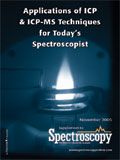
Mass Spectrometry for Forensic Analysis: An Interview with Glen Jackson
November 27th 2024As part of “The Future of Forensic Analysis” content series, Spectroscopy sat down with Glen P. Jackson of West Virginia University to talk about the historical development of mass spectrometry in forensic analysis.
Detecting Cancer Biomarkers in Canines: An Interview with Landulfo Silveira Jr.
November 5th 2024Spectroscopy sat down with Landulfo Silveira Jr. of Universidade Anhembi Morumbi-UAM and Center for Innovation, Technology and Education-CITÉ (São Paulo, Brazil) to talk about his team’s latest research using Raman spectroscopy to detect biomarkers of cancer in canine sera.